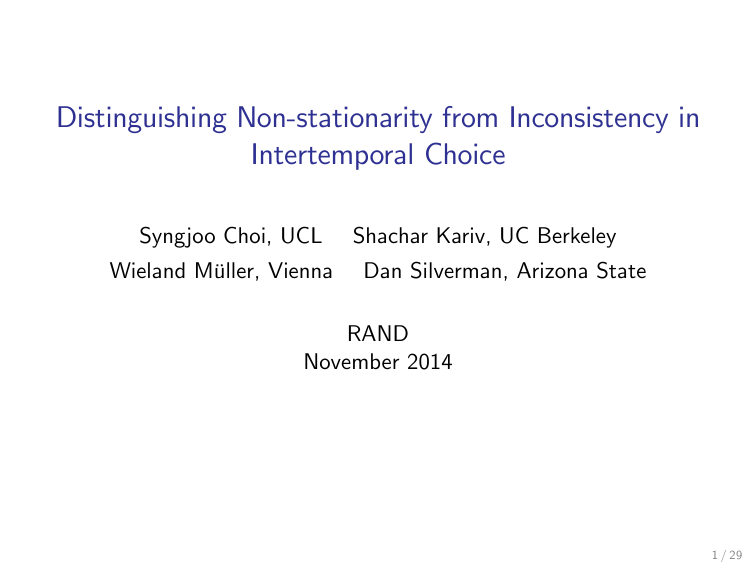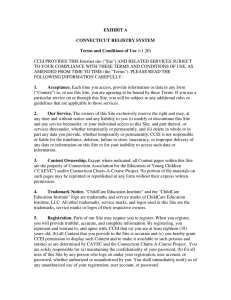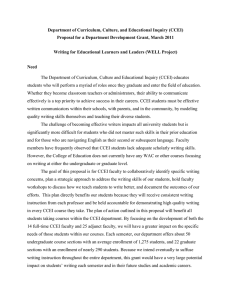Distinguishing Non-stationarity from Inconsistency in Intertemporal Choice
advertisement

Distinguishing Non-stationarity from Inconsistency in Intertemporal Choice Syngjoo Choi, UCL Wieland Müller, Vienna Shachar Kariv, UC Berkeley Dan Silverman, Arizona State RAND November 2014 1 / 29 Background Models of time-inconsistency have attracted attention In particular, non-constant time discounting captures problems of self-control to great e¤ect. Hyperbolic or quasi-hyperbolic preference also …nd empirical support in experiments I Frederick et al. (2002) review Recent experimental studies argue this evidence (re: money rewards) isn’t robust. I Andersen et al. (2011), Augenblick et al. (2013), Andreoni Sprenger (2012), Gine et al. (2013), Halevy (2014) Lean toward other forms of non-stationarity 2 / 29 This Paper Presents a novel design for use on time preferences Collects rich, individual-level data Richness allows nonparametric analysis of consistency with utility maximization and stationarity of time preferences. Examine both traditional lab environment and a …eld enviroment 3 / 29 Preview of Results Findings support a di¤erent view of what appears like non-stationarities Lots of individual heterogeneity, both in demand behavior and levels of consistency Inconsistency, per se, is quantitatively more important than any form of non-stationarity. 4 / 29 Experimental Design: Environments Experiments are conducted at: I I Xlab at UC Berkeley CentERpanel in the Netherlands CentERpanel, online household panel survey with more than 2,000 hhlds (5,000 individuals). 1,636 participated I 211 in Xlab, 1,425 from CentERpanel 5 / 29 Experimental Design: Basics Now fairly standard method in choice under uncertainty New for intertemporal choice problems Problem is to select a bundle of time-dated income from a budget set. Graphical interface allows a lot of rich data to be collected quickly. 6 / 29 7 / 29 Advantages Choice of a bundle from a budget constraint provides more information about preferences than discrete choice. Large menu of decision problems gives economically complete and statistically powerful picture. Allows interpretation of behavior at individual level. 8 / 29 Experimental Design: Details Subject chooses from budget line bundles consisting of some income sooner and some income later Choice problems (E) involve tradeo¤s between income today and 60 days later Choice problems (L) involve tradeo¤s between income in 60 days and 60 days after that. Static experiment with exact same budget lines – randomly ordered. Subjects paid by direct deposit (NL) or virtual debit card (Berk.) 9 / 29 Theory: Consistency Logcially prior, but understudied question about intertemporal choices: Are they consistent with utility maximization? GARP requires that if (x, t) is indirectly revealed preferred to (x0 , t0 ) then (x0 , t0 ) is not strictly and directly revealed preferred to (x, t) . If (x, t) is revealed preferred to (x0 , t0 ), then (x, t) must cost at least as much as (x0 , t0 ) at the prices that prevail when (x0 , t0 ) is chosen. GARP implies there exists a complete, transitive preference ordering. 10 / 29 Theory: Consistency Afriat’s (1967) Theorem: The following are equivalent The choice data satisfy GARP There exists a non-satiated utility function that rationalizes the data There exists a concave, monotonic, continuous, and non-satiated utility function that rationalizes the data. 11 / 29 Theory: Consistency Afriat’s (1972) Critical Cost E¢ ciency Index (CCEI) CCEI measures the smallest fraction by which all budget constraints must be shifted to remove all violations of GARP CCEI 2 [0, 1] , values closer to one are closer to perfect consistency with GARP, and thus utility maximization. Because subjects make choices from wide range of budget sets, data provide a stringent test. 12 / 29 Constructing the CCEI x2 D C B A y x x1 13 / 29 14 / 29 15 / 29 16 / 29 Correlates of Near-term CCEI 17 / 29 Correlates of Far-term CCEI 18 / 29 Stationarity, Time Invariance, and Time Consistency Early experiments show time discount rates decline as tradeo¤s are pushed into the temporal distance Subjects often choose the larger and later of two rewards when both are distant in time, but prefer smaller sooner as both draw near to the present. Interpreted as non-constant time discounting and problems of self-control 19 / 29 Stationarity De…nition t is stationary if for every t, t0 (x, t + ∆1 ) t 0 and ∆1 , ∆2 x0 , t + ∆2 () x, t0 + ∆1 0 t x0 , t0 + ∆ 2 Ranking does not depend on the distance from t. This is what is tested in a standard experiment. 20 / 29 Time-Invariance De…nition f T t g t=1 is time-invariant if for every t, t0 (x, t + ∆1 ) t 0 and ∆1 , ∆2 x0 , t + ∆2 () x, t0 + ∆1 t0 0 x0 , t0 + ∆ 2 Ranking does not depend on calendar time. Payments are evaluated according to stopwatch time. 21 / 29 Time-Consistency De…nition f%t gTt=1 is time-consistent if for every t, t0 (x, t + ∆1 ) t 0 and ∆1 , ∆2 (x0 , t + ∆2 ) () (x, t + ∆1 ) t0 0 (x0 , t + ∆ 2 ). Ranking does not change as the evaluation perspective changes from t to t0 . Time consistency precludes dynamic preference reversals. Properties are pair-wise independent, but any two properties imply the third (Halevy, 2014) 22 / 29 Lots of Static Preference Reversals 23 / 29 GARP-based Test of Stationarity A non-parametric approach for testing whether there is a single preference ordering that can rationalize all intertemporal choices (for a given subject) Combine dataset E with dataset L. Compute the CCEI for this combined dataset. Compare that number to the minimum CCEI in each of the separate treatments. The CCEI for the combined dataset can be no bigger than the minimum of the CCEIs for the separate datasets E and L. 24 / 29 25 / 29 26 / 29 Statistical (Permuation) Tests of Stationarity . Think of the treatment as the time frame Null hypothesis is that there is a single preference ordering that can rationalize choices in both near and far time frames. Distribution for a test statistic under the null hypothesis is obtained by permuting the two choice sets I Randomly reassign a choice from dataset E or L to each budget line. We compare the actual CCEI, Varian (1991) and MPI scores with their permutation distribution. 27 / 29 Results Little evidence of non-stationarity We reject a null of stationarity for only a small fraction of the subjects. Signi…cance level CCEI Varian MPI 1 6.60 6.60 7.55 5 8.49 10.38 10.38 10 14.15 13.21 16.04 28 / 29 Summary Experimental interface allows rapid collection of rich choice data Permits individual-level analysis of intertemporal choice with new depth. Non-parametric analysis indicates that inconsistency is quantitatively more important than non-stationarity. Point to modeling inconsistency more than “exotic” preferences. 29 / 29






